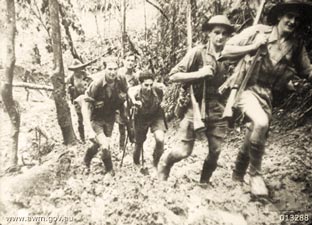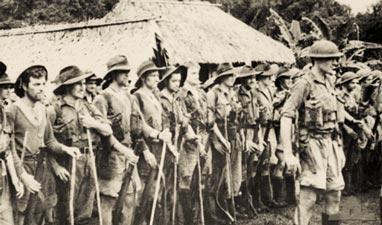 On the Track (Photo courtesy of Australian War Memorial
On the Track (Photo courtesy of Australian War Memorial)
Japanese forces landed at Gona, on the north coast of Papua, in July 1942 and began to move inland soon after. The 39th Militia Battalion and elements of the Papuan Infantry Battalion were sent to stop them and the first clash occurred at Awala on July 23. Heavily outnumbered and ill-equipped for jungle warfare, the Australians were forced back. Using tactics of leap-frogging ambushes and setting up major defensive positions where terrain was suitable, they inflicted heavy casualties and delayed the Japanese advance.
Exhausted after a month of continuous fighting, the 39th Battalion was finally reinforced by the 21st Brigade of the AIF (regular army) during the Battle of Isurava on August 23. From here the Australian forces were slowly forced back to Eora Creek on 30 August, Templeton’s Crossing on 2 September, and Efogi by September 5, extracting a high price from the Japanese for their advance. The 39th Battalion was finally relieved by the 25th Brigade AIF, to be joined by the 3rd Militia Battalion on September 5 when they took up defensive positions on Iorobaiwa Ridge. After a fierce 4-day battle, the Australians were forced to retreat to Imita Ridge, where they prepared to make a final stand.
From Iorobaiwa Ridge, the Japanese could see the glow of Port Moresby but the casualties and delays forced on them by the Australians had taken their toll. Now it was the Japanese turn to be over-stretched, on the wrong end of a thin supply line and, for the first time, within range of the Australian artillery. With troops starving, munitions running low and no possibility of reinforcements due to commitments in the Battle on Guadalcanal, they were ordered to "advance backwards" (the term retreat not existing in the Japanese military vocabulary) on September 24. Joined by the 16th Brigade, the Australian forces harried them all the way, fighting a cruel war of patrol and ambush, with pitched battles at Templeton's Crossing and Eora Creek, against a desperate Japanese rear-guard.
 Those "ragged bloody heroes" (Photo courtesy of Australian War Memorial)
Those "ragged bloody heroes" (Photo courtesy of Australian War Memorial)
The mountains were crossed and Kokoda was retaken on November 2. The campaign now entered a different and even more bloody phase, as the Japanese were trapped with their backs to the sea. They fought to the bitter end before being completely routed by an Australian force that included the 16th and 25th AIF Brigades, plus the 3rd and 39th Militia Battalions, aided by newly arrived American troops, in the Battles of Buna, Gona and Sanananda. By the end of January 1943 the campaign was over.
During the Kokoda campaign, Australian forces lost 625 killed and 1055 wounded. A further 1394 were killed and 2478 wounded in the battles for the northern beaches. Such were the conditions that for every battle casualty another three were stricken by tropical disease - malaria, typhus, dysentery. No history of the Kokoda Track, no matter how brief, would be complete without an acknowledgment of the fuzzy-wuzzy angels, the Papuan porters who carried in supplies and carried out the wounded troops. Without their contribution, these numbers would have been much higher.
* This is only a very brief account and may omit the contributions of some army units. For a full description of the campaign, I would recommend reading Bill James "Field Guide to the Kokoda Track", written for the trekker who wants to understand what happened there.
